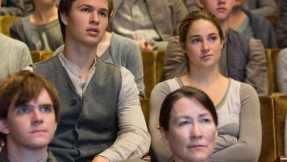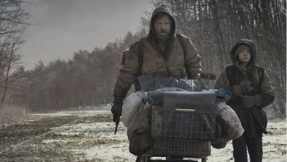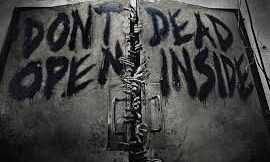Emerging trends of Dystopian Nightmares

Dystopian and post-apocalypse genres are on the rise with novels such as The Hunger Games by Suzanne Collins and Divergent by Veronica Roth, achieving much success in film as well as in print. Following the success of these trilogies are many novels of the same genre, such as Delirium by Lauren Oliver and The Maze Runner by James Dashner. Older titles such as Lois Lowry’s The Giver, appear to be looking to capitalise on the trend’s success with a film adaptation set for release twenty-one years after the novel was first published. Many of these novels appear under the collective genre of science fiction and dystopia. However, a comparison to these recent bestsellers and older titles that are foregrounded in the dystopian genre, such as George Orwell’s timeless 1984, singles out emerging sub-genres and alternative categories within the larger heading of dystopian novels.
There are two types of polarity that can be seen in the rising trend: the rise of the pulp-populars versus, the literary post-apocalypse novels.
The Pulp-popular series
The pulp-populars include the lighter novels, the PG-rated and child friendly stories that entice their readers to despise the authoritarian government in charge, in addition to cooing at the equally important ongoing love story.
The Hunger Games pushes the boundaries of light dystopia versus dark dystopia with the violence based plot and killing of children by other children. Nevertheless, this brutality is nothing compared to the violence displayed in the similar novel, Battle Royale by Koushun Takami, where school students are forced to battle each other to death by their authoritarian government.
Suzanne Collins and many writers of the pulp-populars often make use of the first-person narrative. This focuses the reader’s attention on the plight and journey of the main character. A significant part of The Hunger Games success lies with the extremely relatable and likeable protagonist, Katniss Everdeen. She is a strong and resilient character and a refreshing female image to star in dystopian novels, as opposed to the classical dystopian titles which tend to feature male characters. Like the rest of District 12, the reader is inspired by Katniss’ symbolic hand gesture, her decision to eat the poison berries at the end of the first novel and her mocking jay pin, which all serve as symbols of Katniss’ rebellion.
In Stephen King’s review for Entertainment Weekly, the author praises the book’s addictive quality whilst acknowledging its shortcomings. He compares the novel to a:
shoot-it-if-it moves videogames in the lobby of the local eightplex; you know it’s not real, but you keep plugging in quarters anyway… There are displays of authorial laziness that kids will accept more readily than adults.
King states that the love triangle is standard for the genre and awards the novel an overall B grade. One might agree with King’s assessment that the fast paced action of the novel does not overcome the moments of “authorial laziness”. This is exemplified in the final novel of The Hunger Games trilogy, where important characters are dying left right and centre. Katniss’ sister Primrose’s death happens suddenly and occurs arguably as an unnecessary feature of the central plot. The act that caused Katniss to enter the games in the first place, the goal of protecting her sister, fails and Katniss is left broken and depressed. The final passages of the novel somewhat balance the former chaotic passages as they offer some images of hope: members of District 12 returning home again and ash-filled meadows turning green.
 Other pulp-populars following on from the Hunger Games success contain similar features: love triangles, use of the first-person narrative and a strong female heroine. In addition there is frequent use of the ‘bildungsroman’ genre, the coming-of-age story.
Other pulp-populars following on from the Hunger Games success contain similar features: love triangles, use of the first-person narrative and a strong female heroine. In addition there is frequent use of the ‘bildungsroman’ genre, the coming-of-age story.
For example, the major action of Divergent takes place at the crucial stage of a teenager’s development when the protagonist, Beatrice, is about to decide which faction she will belong to for the rest of her life. The decision to move away from her parents and the struggles of discovering who she is as an individual away from home are integral parts of the novel. At the end of the novel Beatrice reflects on how her decision to move away from her parents has left her and her family factionless and separate from the government. In realising this, Beatrice, is able to see the advantages this unique position may provide for her:
I do not know what life will be like, separated from a faction – it feels disengaged, like a leaf divided from the tree that gives it sustenance. We are creatures of loss; we have left everything behind. I have no home, no path, and no certainty. I am no longer Tris, the selfless, or Tris, the brave. I suppose that now, I must become more than either. (487)
Beatrice feels a great sense of loss at being a ‘factionless’ individual. She also realises that in rebelling against the strict regimented faction system, Beatrice is now free of all former labels that have tried to categorise her, and she now has the opportunity to forge a new path for herself.
The Hunger Games and Divergent provide small insights as to why the pulp-populars are so successful. The first person narrative, fast-paced action, love triangles and fact that the pulp-populars are often published in trilogies, all serve as the main reasons why the pulp-populars are able to translate so well into film and settle permanently into the hearts of their large fan groups.
The Literary Post-apocalypse series
There is often much controversy surrounding the practice of categorising high and low brow literature. The literary post-apocalypses however, do not only include the golden classics. Under this label one might include The Walking Dead television series based on the comic book series of the same name by Robert Kirkman, The Road by Cormac McCarthy and The City and the City by China Mieville, all of which have been published this century.
The literary post-apocalypses are often written in third-person with a focus on several main characters rather than one central figure. A larger set of characters and inclusion of sub-stories enables the author to explore their imagined future through multiple perspectives thus making the futuristic world more accessible to the reader.
Novels such as Never Let Me Go by Kazuo Ishiguro and The Handmaid’s Tale by Margaret Atwood have more developed concepts and original imaginative settings at the heart of their stories. For example, The City and the City portrays a country where two cities live side by side and its inhabitants live under strict rules that force them to ignore and ‘unsee’ the city that that they live opposite. The citizens of each city are strictly forbidden to recognise each other on pain of severe penalties to be carried out by a supreme authority known as Breach. The novel can be interpreted in many ways, one noticeable metaphor is how the citizens of the city resemble our modern day tendency to ‘unsee’ and ignore that which does not directly affect our lives.
 As mentioned before, the literary post-apocalypses are darker and more violent than the pulp-populars. The Road by Cormac McCarthy tells the seemingly simple story of a man and his son heading to the coast by walking along a main road after an apocalyptic event has destroyed most of the world. It is a story of survival in intense bleak conditions. The idea that humanity has boiled down to such a starch and unforgiving landscape in the future is terrifying. The characters live in a strange state where they are not quite living nor dying. The father of the boy regularly places his hand on his son’s chest to check that his heart is still beating. He confesses to the reader that his only reason for living is his son as the world has nothing to offer for him anymore. McCarthy writes in a beautiful poetic manner that refrains from attempting long philosophical assessments of the situation. Instead the father’s short reflections are hauntingly speculative and suggestive as to what life means:
As mentioned before, the literary post-apocalypses are darker and more violent than the pulp-populars. The Road by Cormac McCarthy tells the seemingly simple story of a man and his son heading to the coast by walking along a main road after an apocalyptic event has destroyed most of the world. It is a story of survival in intense bleak conditions. The idea that humanity has boiled down to such a starch and unforgiving landscape in the future is terrifying. The characters live in a strange state where they are not quite living nor dying. The father of the boy regularly places his hand on his son’s chest to check that his heart is still beating. He confesses to the reader that his only reason for living is his son as the world has nothing to offer for him anymore. McCarthy writes in a beautiful poetic manner that refrains from attempting long philosophical assessments of the situation. Instead the father’s short reflections are hauntingly speculative and suggestive as to what life means:
He walked out in the grey light and stood and he saw for a brief moment the absolute truth of the world. The cold relentless circling of the intestate earth. Darkness implacable. The blind dogs of the sun in their running. The crushing black vacuum of the universe. And somewhere two hunted animals trembling like ground-foxes in their cover. Borrowed time and borrowed world and borrowed eyes with which to sorrow it.
Translated onto the big screen, the film adaption of the novel offers grey landscape after grey landscape, amplifying the images of a dead world from the novel to a whole other level.
What is it about the end-of-the-world scenario that has us hooked?
The reader is able to realise their worst fears as a citizen of a developing world through pulp-populars and literary apocalypses. These fears include the dangers of knowledge and fears of where technology might lead us in a climate sensitive world. In realising our worst fears and anxieties, the dystopian and science fiction literature provide the unique quality of enabling writers and readers to explore the negative aspects of our humanity: greed, betrayal, cowardice and where these characteristics may lead humans in the future.
 In addition, the perverse attraction to dark story lines, violence and horror cannot be ignored as a significant factor that engages our interest in both the pulp-populars and literary post-apocalypses. The Walking Dead series is particularly merciless when it comes to sparing its characters’ happiness. One might expect the characters to find a refugee shelter or underground government compound that has survived the zombie apocalypse. The show plays with the viewers’ expectations by continually throwing obstacles in the way of their characters. It raises the question of why do the viewers expect there to be a refugee shelter? What if the world really was overrun with zombies leaving only a handful of survivor groups? It is a horrible future to consider, and yet many viewers are still looking for a happy ending in this post-apocalyptic TV series. It seems that the search for a happy ending and desire for the characters to achieve their goal of survival is what draws viewers back to the show episode after episode.
In addition, the perverse attraction to dark story lines, violence and horror cannot be ignored as a significant factor that engages our interest in both the pulp-populars and literary post-apocalypses. The Walking Dead series is particularly merciless when it comes to sparing its characters’ happiness. One might expect the characters to find a refugee shelter or underground government compound that has survived the zombie apocalypse. The show plays with the viewers’ expectations by continually throwing obstacles in the way of their characters. It raises the question of why do the viewers expect there to be a refugee shelter? What if the world really was overrun with zombies leaving only a handful of survivor groups? It is a horrible future to consider, and yet many viewers are still looking for a happy ending in this post-apocalyptic TV series. It seems that the search for a happy ending and desire for the characters to achieve their goal of survival is what draws viewers back to the show episode after episode.
Finally, with most dystopian and post-apocalyptic novels and films, there is the element of familiarity. No matter how far into the future the stories propel their readers, there is often the ability to relate with the characters and social system in place. In 1984 one might connect with the sense of paranoia Winston feels that the government is always watching and attempting to control its citizens. Regardless of how horrifying the concept is, one might be able to relate to the fascination the citizens of the Capitol have with watching the hunger games in comparison to how fascinated people are with reality TV today.
The growing market for young-adult dystopian nightmares is a great success for the genre. Some critics and sci-fi fans have been disappointed with many of the post-apocalypse novels that are churning their way out of bookshops at such a rapid rate. They argue that emphasis on political conflicts and the dying intellect of humanity are elements that are slowly being traded in for love triangles and young ditzy female heroines. However, one might argue that not all of these bestsellers should be written off so quickly. It would be unfair to expect an Orwellian level of writing from every novel. Indeed, why should any author want to write a dystopian novel like Orwell? Times have changed and true originality is such a rare achievement that one should never stop striving for it.
Instead, one can appreciate the new trends and sub-genres appearing under such a well-respected genre as dystopia and science-fiction, since both categories have a lot to offer for their readers.
Works Cited
King, Stephen. “Book Review: The Hunger Games”. Entertainment Weekly. February 26 2010.
McCarthy, Cormac. The Road. (London: Picador, 2009).
Roth, Veronica. Divergent. (EPub Edition: Pan-American, 2011).
What do you think? Leave a comment.











Great read! I loved learning about the two different forms of dystopian novels. Not only did you provide a thorough analysis distinguishing the two types, but you also recommended a few more books to add to my To-Read list. Nice work!
I am currently writing a term research in school about the Hunger Games as a dystopian novel and I would like to use your article as a source for it.
That sounds like a really interesting project, and of course you’re welcome to use my article as a source.
Great post. I love dystopian novels. The Hunger Games and Divergent are what really got me interesed in dystopian fiction.
Anyone interested in this genre, I highly recommend Unwind if you are looking for one to start with. It’s my favourite of all the books I’ve read so far this year.
I took a YA Lit class back in college and read Feed… that was seven years ago and I have read it probably three times since then. Fantastic book. And scary to consider. Really, I think dystopian books are still written our of fear of the future and technology, and Feed is an excellent example of this. I love the internet, but I do NOT want it in my head!
Yes, Feed is very good…made my scalp crawl.
I definitely agree! I haven’t read Feed, will have to add it to my reading list it sounds good.
Woot! You improved the tone and details of this article so much! Nicely revised. Good quotes. I think so much more could be said about this–“In realising our worst fears and anxieties, the dystopian and science fiction literature provide the unique quality of enabling writers and readers to explore the negative aspects of our humanity: greed, betrayal, cowardice and where these characteristics may lead humans in the future.”
Good job ^_^
Thank you!
Good post! I never thought about why dystopia is so big right now, but you bring up a lot of good points.
I think dystopia is very popular because this is particular historical moment where we are really seeing the cracks in our society. It seems we both fear the future, but also want to fix it. I just seems no coincidence to me that the rise in the popularity of dystopia coincides with Occupy Wall Street, battles over women’s reproductive rights, a dismal economy, etc.
I definitely agree, that historical perspective definitely plays a role aswell. Many dystopian novels like 1984 and Farenheit 451 were published after major wars.
As a young adult, I primarily read dystopia because it’s the only thing out there of interest.
Dystopian fiction–if it is good and presents positive characters in the mix–can help readers prepare for future challenges in a world that seems to be increasingly difficult to comprehend. Even for well-versed adults and parents.
Awesome article on a topic that is really so relevant. EVERYTHING is dystopian nowadays. Let’s just hope reality doesn’t end up this way now too~ Great job~
I think recent dystopian books lacks the reflection of our own society. Hunger Games is a great example. Though an entertaining read, it lacks any social commentary.
Katniss is a great example of modern youth and how resistant they are to going against the status quo. I mean Katniss goes into the games twice and is still emotionally and politically flip flopping between boys, how she should act out her femininity on stage, and her stance towards the state. Its sad commentary how the over abundance of choice cripples our ability to choose. The odd thing about katniss’s situation is that most of her choices come in binary sets and she is still flip flopping between the two.
Blog: interrogatingideologywithachainsaw.blogspot.com/
In spite of all the violence and domination in these dystopian novels, they always include elements of hope.
Great article! The worry that the young-adult genre is replacing “the dying intellect of humanity” with a protagonist torn between two love interests is a valid concern. I remember joking with my friends that the readers, us included, were the Capitol because lots of us were more focused on who Katniss would choose as her love interest and not really talking much about the fact that children were killing children in blood sport. The “big issues” get pushed to the background in the young-adult genre, but I don’t think that is necessarily a bad thing. Please excuse my blanket statement, but most young adults are more focused on social relationships and what to do with the rest of their lives so it makes sense to touch on the issues without cracking them wide open just yet.
I had never thought of it like that before but you’re right! We are like the Capitol when we focus on the love story, it goes to show how valid the author’s criticism of Reality TV is. While I usually don’t like statements how the young aren’t engaged enough with important worldwide conflicts, I cant help agree with you that often the big issues are pushed to the background with the young adult genre.
I loved this article, thank you. Thoughtful and insightful. I thought it was great that you use the popularity of the ‘Hunger Games’ and ‘Divergent’ to draw the attention of the reader to literary works which do so much more with these dystopian themes. I’m also really pleased you decided to include The Walking Dead in your study as one of the ‘literary’ works. I know a lot of people see it as just being like a video game in terms of violence but I think the story and script are really excellent, and the show constantly pushes the boundaries of what we, as a viewer, can endure.
I really enjoyed your article especially the layout. The idea that these texts exercise our fears is just so interesting to me. I think the cathartic feeling we receive when we watch these stories play out with a ‘happy’ ending shows how much we need literature to understand ourselves.